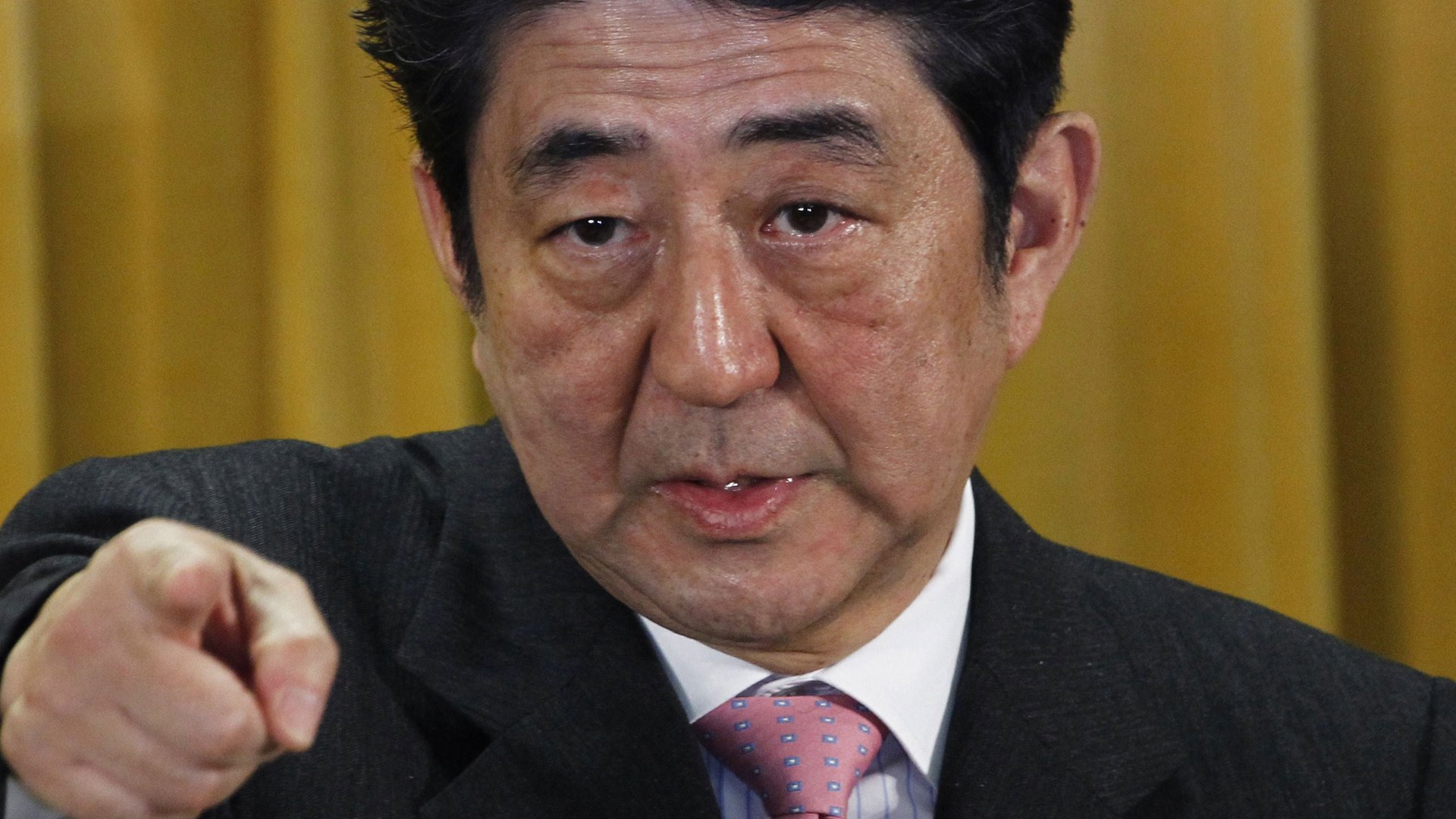Abe is planning a massive fiscal stimulus—but what’s left to stimulate?
The Liberal Democratic Party stormed the Diet, catapulting Shinzo Abe back into the prime ministership and handing him majority clout, in what Quartz previously declared ”an outright referendum on the Bank of Japan” and its flaccid monetary policy. But Abe ran on “economic recovery” writ large—and, as the the new prime minister notes, his monetary policy won’t take effect for many months.


The Liberal Democratic Party stormed the Diet, catapulting Shinzo Abe back into the prime ministership and handing him majority clout, in what Quartz previously declared ”an outright referendum on the Bank of Japan” and its flaccid monetary policy. But Abe ran on “economic recovery” writ large—and, as the the new prime minister notes, his monetary policy won’t take effect for many months.
Enter Abe’s fiscal plans. In addition to cheap money, Abe is also promising a public-works shopping spree, budgeting a $119-billion fiscal stimulus for the first quarter of 2013 alone. Over the next 10 years, the LDP will shovel $2.4 trillion into public-works programs.
So Abe’s keen on Keynes—that much is clear. Still mysterious, however, is what there is left to invest in given the government’s on-again/off-again public works spending throughout the last two decades.
In other words, what do you buy the country that has it all?
More concrete, it turns out. Based on the LDP’s emphasis on “public works,” Abe seems to think a country can’t have too much of it. And this, frankly, is worrisome. Given Japan’s past of chronic boondoggling—and that infrastructure projects tend to have relatively low job-creation multipliers—the economic payoff of this approach looks questionable. Plus, many fear that its two-decade stimulathon has left Japan bloated by excess capacity, which could stymie Abe’s efforts to use monetary and fiscal expansion to wrest the country of its deflation death-spiral. (And let’s not even start with Japan’s already off-the-charts public debt load.)
Still, as Reuters points out, this will be a boon for Japan’s “construction state,” boosting companies like Kajima, Taisei, Obayashi, and Shimizu. Construction-machinery majors like Komatsu, Kubota, and Hitachi are probably thrilled, particularly given that the Democratic Party of Japan (DJP) cut public works budgets significantly during its tenure.
This isn’t to say that all public works spending is unnecessary. The 2011 earthquake signaled the critical need for disaster prevention infrastructure. At minimum, the LDP aims to rebuild bridges, public buildings, dams, and tunnels to withstand earthquakes. It also will continue to focus on rebuilding roads, bridges and tunnels that the 2011 earthquake and tsunami leveled. Since the previous government’s stimulus somewhat bungled these efforts, plenty remains to be done.
Though infrastructure is a perennial Japanese fave, there’s past precedent for a more creative approach to fiscal stimulus. In 2008, Japan’s budget focused on alternative energy, including solar batteries, electric cars, and energy-saving consumer electronics. And with good reason: Japan imports the vast majority of its energy, and only around 20% of its total energy use currently comes from alternatives. The government rolled out a limited eco-car subsidy for part of this year, so it may need to turn to other sectors to stimulate consumption. However, if it does reboot those subsidies, it’s worth noting that, though Japan currently sources from China 80% of the rare earth used in electric motors and hybrid batteries, Japanese auto manufacturers are making headway on recycling and otherwise diminishing reliance on these.
Speaking of which, though the LDP has traditionally been antagonistic toward China, Abe’s recent vagueness about both the Senkaku/Diaoyu Islands dispute and the Yasakuni Shrine issue may signal a certain skittishness about the prospect of more seaborne skirmishes. That issue is likely related to another potentially stimulative measure of the new government: Abe’s aim to up defense outlays. Spending $59.3 billion in 2011, Japan ranked fifth in global defense expenditures, just behind France’s $62 billion. At present, most of this goes toward imported American weaponry.
But Japan’s defense spending could be a lot higher. For the last half-decade, the budget has allotted a mere 1% of GDP to defense spending, compared with 4.7% of the US GDP. A major reason for that is Japan’s restrictions on military activity enshrined in its constitution—something Abe proposes changing. In addition to allowing joint-military exercises with allies, Abe’s plan would aid Japan’s defense industry, since the constitution currently forbids these companies from exporting most weaponry. Making the export of domestic weaponry explicitly legal could boost sales for Japanese companies with defense-related divisions, including Mitsubishi Heavy, Toshiba, NEC, Fujitsu, Komatsu, Shinmaywa Industries, Kawasaki Heavy Industries, and IHI Group.
Still, Western defense primes like Lockheed Martin and BAE won’t be threatened any time soon. The constitution’s long-standing export ban has given them a half-decade head start over Japanese companies in developing top-end security technology. And with China and North Korea as neighbors, few would be the prime ministers looking to scrimp on missile defense. Least of all one with such an urgent yen to spend.